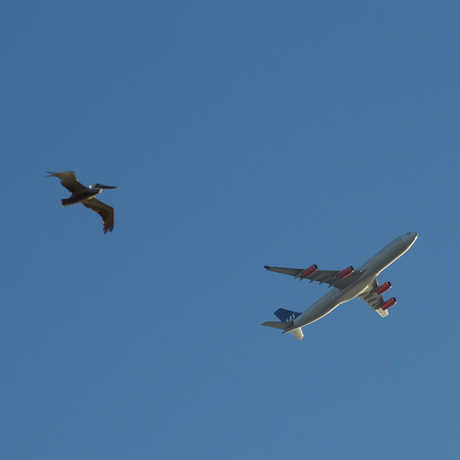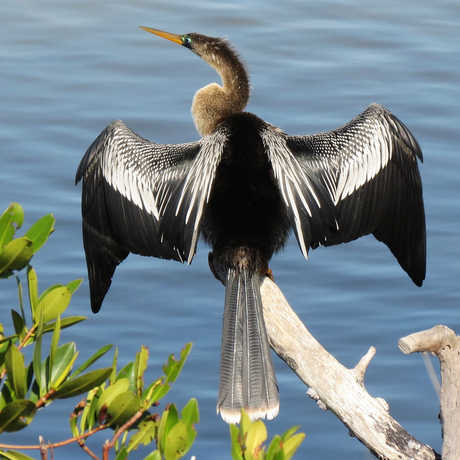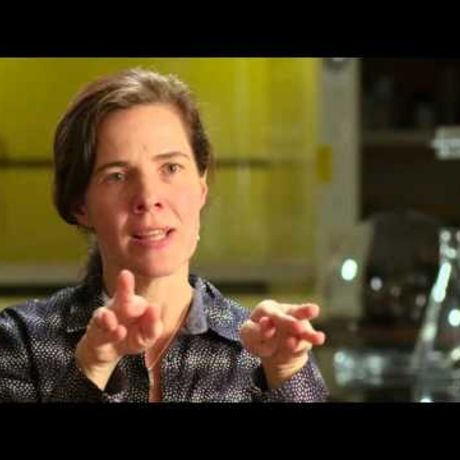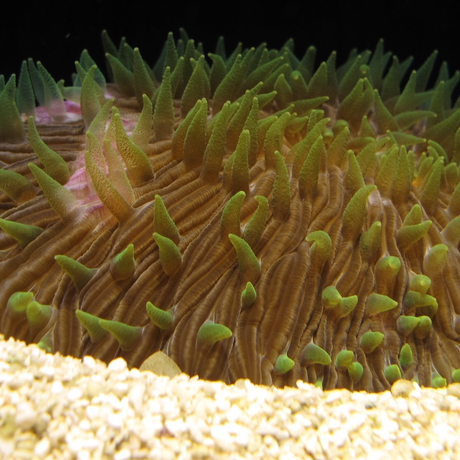Learn the benefit of using videos in the classroom, and browse resources to help you get started.
Armed with the latest technology, scientists are beginning to unlock the secrets of one of nature’s most acrobatic flyers.
About This Video
Grade level: 6-13+
Length: <8 minutes
Next Generation Science Standards: PS2.A, PS3.A, PS3.B
Summary
Capable of aerial maneuvers that put even the most advanced human-made flying machines to shame, hummingbirds are true masters of flight. As the tiny birds move from flower to flower, they appear to almost levitate—hovering in mid-air, practically motionless except for their blur of wings beating more than 40 times per second. Although scientists have studied hummingbirds for centuries, the secrets of the birds’ sustained hovering ability have remained a mystery. But that may soon change. Researchers at Stanford’s Lentink Mechanical Engineering Lab have invented a device—a flight chamber outfitted with high-speed video equipment and ultra-sensitive pressure plates—that may finally explain how hummingbirds achieve their astounding aerial feats. By measuring the forces generated by a hummingbird’s individual wing beats, the scientists have developed the most accurate and detailed model yet of the physics involved in the hummingbird hover. Their model proves the existence of a hidden mechanism that enables the birds to achieve what might otherwise be impossible—and could one day help engineers design better flying machines.
Video Discussion Questions
- What is unique about hummingbirds' flight? What can hummingbirds do that even manmade airplanes cannot?
- How do the scientists in the video study hummingbird flight dynamics? What are they trying to find out?
- What can you observe about the flight of hummingbirds in time-lapse video that you wouldn't otherwise be able to see?
- How many times does a hummingbird flap its wings every second?
- How do birds and airplanes fly? What are the forces involved?
- What are the potential applications of understanding hummingbird flight dynamics?
Classroom Activities to Accompany This Video:
3-2-1

Have students choose a time lapse sequence from this video and watch it without sound. In their science notebooks, ask students to write down:
- 3 things they noticed or observed
- 2 questions they have or things they wonder about, and
- 1 thing they learned
On the board, draw a table with three columns labeled 'I noticed...', 'I wonder...', and 'I learned...'. Have students discuss their observations, questions, and knowledge gained, and write these things in the appropriate column on the board. In addition to the following questions, you can use the About This Video section to engage your students in a deeper dive into hummingbird flight dynamics:
- What is the purpose of time-lapse video?
- How can time-lapse video be used in research, particularly in understanding hummingbird flight dynamics?
- What can you observe about hummingbird flight dynamics with the time-lapse video that you wouldn't necessarily be able to observe otherwise?
- What other applications of time-lapse video can you think of?
The Forces of Flight

How do birds, bats, and airplanes fly? What keeps them in the air?
Lift and Drag
For a bird or airplane to get airborne or climb in flight, their wings must produce more lift than their total weight. In order for an object to move through the air in a stable manner, it must balance four forces: lift, gravity, thrust, and drag.
After watching this video, your students can dive deeper into the physics of flight dynamics with this interactive activity from NOVA.
You can also engage your students in comparing the flight capabilities of planes with birds this interactive activity from Science Learning Hub.
Photo credit: j.lau88
Birds of a Feather

Not all birds fly the same way. Some birds, like hummingbirds, hover and zip around. Other birds soar passively through the air. What accounts for these differences in flight?
After showing your students the How Hummingbirds Hover video, there are many activities they can do to investigate how the wing shapes of birds relates to their differences in flight:
1. Watch other short videos of different kinds of birds in flight (a simple YouTube search will yield a variety of such videos). Ask students to make observations about the different wing shapes of birds and how they relate to the way each bird flies.
2. Paper airplane design challenge: Students can do their own hands-on investigation into how wing shape affects flight by designing, building, and testing paper airplanes. Check out this paper airplane design challenge from Teach Engineering.
- Is it possible to create a paper airplane that can hover like a hummingbird? Why or why not?
- How is a paper airplane different from a bird? Is a paper airplane an accurate representation of a bird? Why or why not?
3. Bring a few different bird feathers to class and allow students to make observations about them. Have students sketch the bird feathers in their science notebooks and write down notes and questions they have about them. Encourage students to hold the feathers loosely between their fingers and blow over and under the feathers to see how they respond.
- How do bird feathers relate to bird flight?
- Can you identify the various structures in a bird feather and make hypotheses about their functions?
Photo credit: James St. John
Video Credits
Produced by Spine Films, this video appears in bioGraphic, a magazine powered by the California Academy of Sciences to showcase both the wonder of nature and the most promising approaches to sustaining life on Earth.
Additional Resources
California Academy of Sciences News: Steady Flight
Read more about how the hummingbird's wing structure helps it achieve its incredible flying dynamics.


